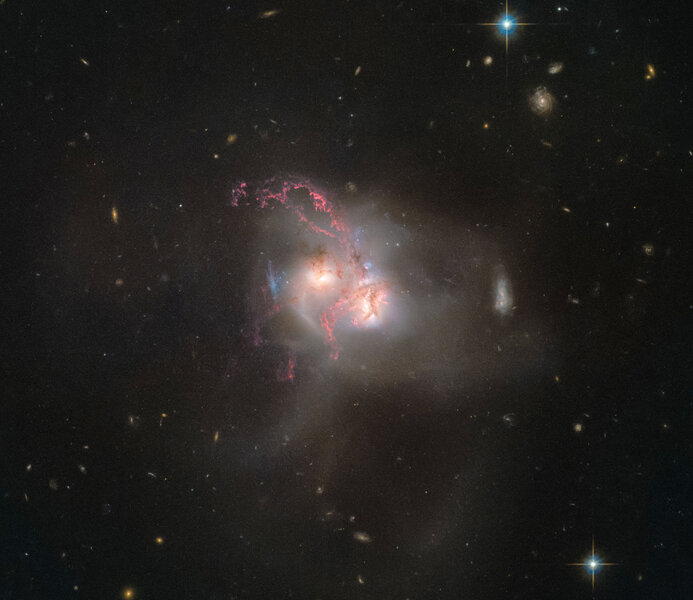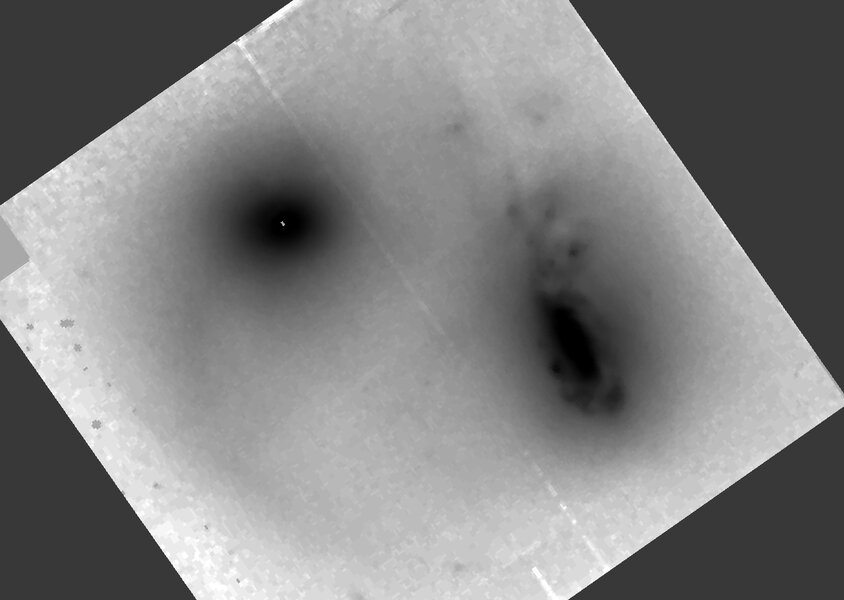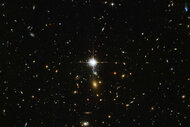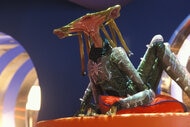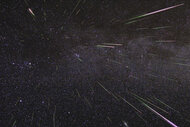Create a free profile to get unlimited access to exclusive videos, sweepstakes, and more!
Two galaxies that did *not* pass in the night
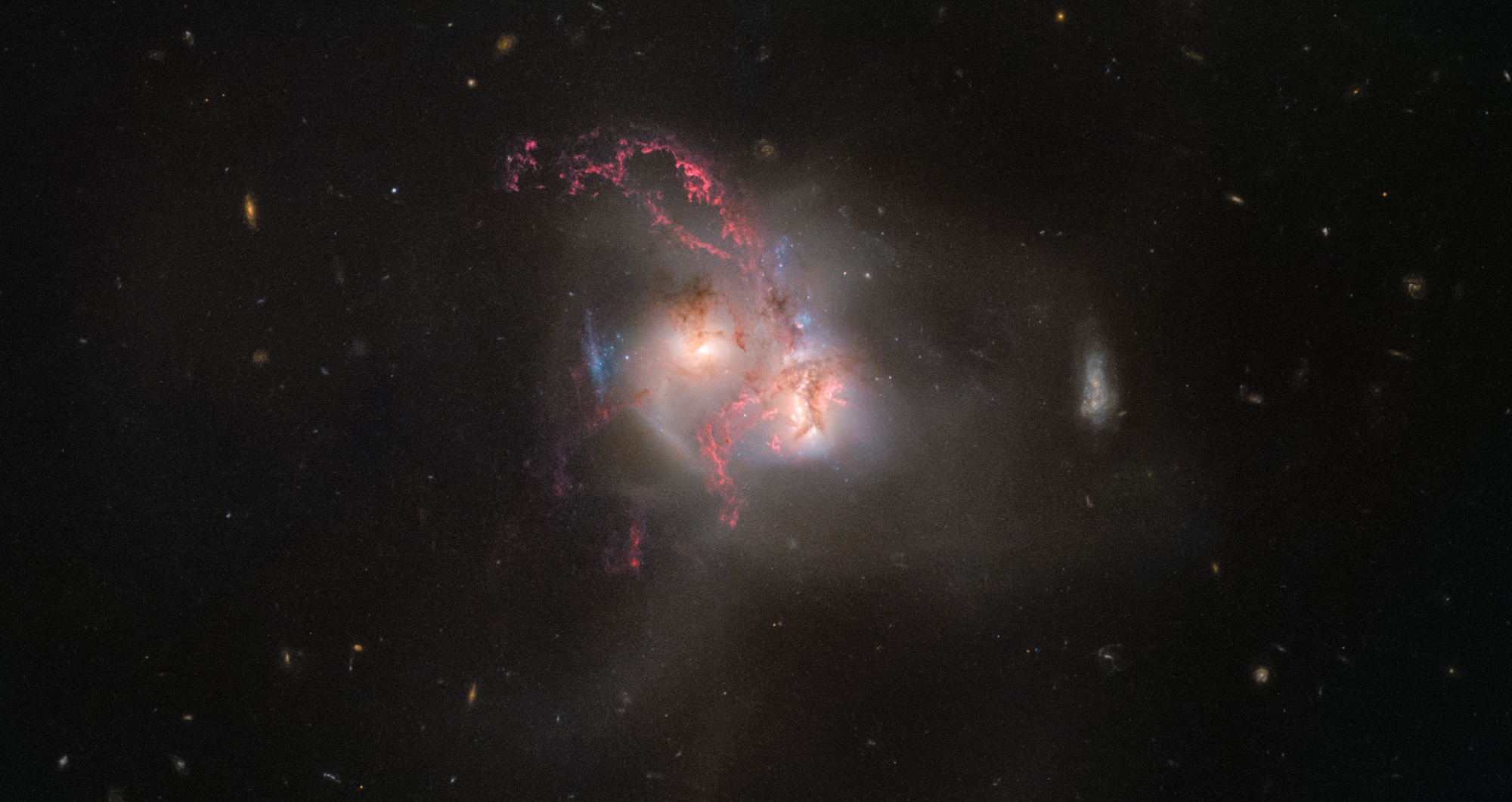
Yesterday I wrote about two galaxies that are literally passing in the night: They're blowing past each other close enough to affect each other profoundly through gravity, but moving so rapidly they cannot merge. They'll just keep on going, each headed off into the Universe in different directions.
… but what would have happened if they hadn't been moving quite so quickly?
Oh, something like this:
This is NGC 5256, as seen by the Hubble Space Telescope: a pair of galaxies that began their collision tens or even hundreds of millions of years ago, and are well on their way to merging.
Wow. Both galaxies started off life as disk galaxies: broad, flattened circular galaxies maybe much like our Milky Way (though roughly half the size). As they approached each other, though, their mutual gravity tore them apart. The slightly off-center pass threw off long arcs of stars, gas, and dust, and the overall shapes of the two galaxies became elongated and warped.
That bright arc of red is interstellar gas flung off by the collision. It's mostly hydrogen, the most abundant gas in the Universe, and common in disk galaxies; it's the raw material galaxies use to make stars*. It dramatically outlines just how energetic galactic collisions are; that streamer is tens of thousands of light-years long!
In fact, this object is such a mess in this image I wasn't sure whether to call it one galaxy or two. Some millions of years ago they were certainly separate, and in the future they'll be one bigger galaxy. But as I poked around the archives looking for other observations, I found this nice (if somewhat low-resolution) Hubble observation of NGC 5256 using NICMOS, an infrared camera:
Ah, that makes more sense (I rotated it to more-or-less match the color image, and it's displayed as a negative, which astronomers sometimes do to emphasize faint details). You can clearly see the two galaxies, separated by a little over 10,000 light-years or so. You can even get a hint of the curved streamers emanating from both; these are called "tidal tails." In this image, the filter emphasizes cooler, red stars. Nothing is unaffected by a galactic collision!
Not even the galaxies' cores. We're pretty sure that every big galaxy in the Universe has a ginormous black hole in its heart; they form along with the galaxy itself and in fact affect each other as they both grow. The Milky Way has one, 26,000 light-years from us, and it's quiescent: It's not actively gobbling down matter and blasting out huge amounts of radiation.
Collisions, though, shake the pillars of heaven, and that can cause a lot of material to fall toward the centers of the two galaxies. As it falls in it forms a huge rapidly rotating disk that heats up and gets incredibly bright. We call these kinds of galaxies active, and it so happens that both galaxies in NGC 5256 are active. They're glowing across the electromagnetic spectrum, radiating away the tremendous crashing energy of their cosmic train wreck.
I love galaxy collisions; they're so ridiculously and epically beautiful, and there isn't any part of them that isn't fascinating. And mind you, when you see this, you're seeing our own fate: The huge Andromeda galaxy is headed right for us! But don't panic. While there will definitely be a collision, and it'll mess us up and good, it won't happen for about 4 billion years. Breathe easy.
And it's not clear what will happen to Earth in the collision. The Sun will still be around, and models indicate it might get thrown into a big looping orbit around the new galaxy's center. … But likely we'll survive the whole event. The galactic center becoming active and lighting up may be a different story, but again, I'll let my great-great-great-(repeat 160 million times) grandkids worry about that. I'm content just to learn what I can about galactic collisions now, and marvel at the fact that the Universe is marvelous.
* A funny aside, if you like astrophysics details: An image like this is actually a composite of several images taken using different filters, which are combined to create a color picture. The filter used to see that hydrogen tail is actually a filter designed to look at the emission from the element sulfur! That threw me for a moment, but then I put it together … the light sulfur emits has a wavelength (a color) of 673 nanometers. Hydrogen emits at 656 nm. But these galaxies are 350 million light-years away, far enough that the expansion of the Universe has redshifted the light, literally making the wavelength longer. At that distance, the wavelength is expanded by a factor of about 1.025 … which means hydrogen at that distance would be seen to have a wavelength of 673 nm. That's why the sulfur filter was used!
